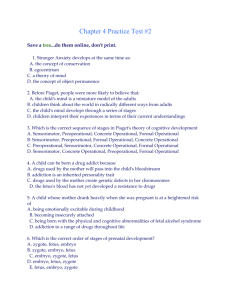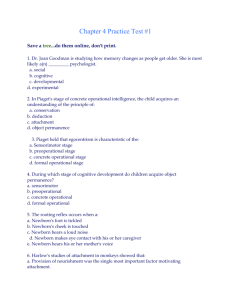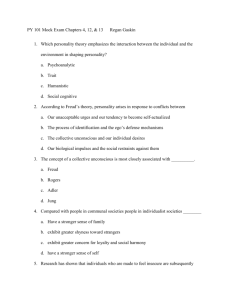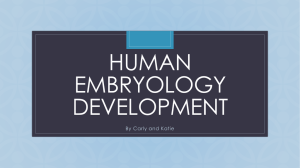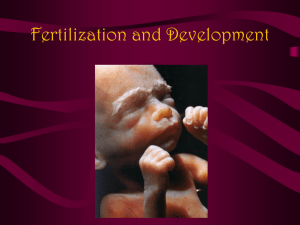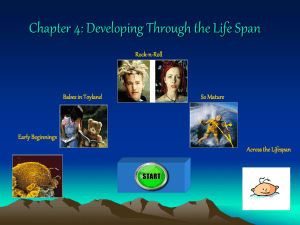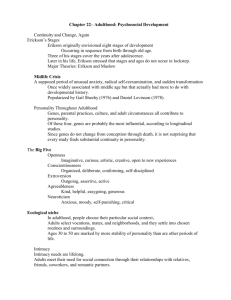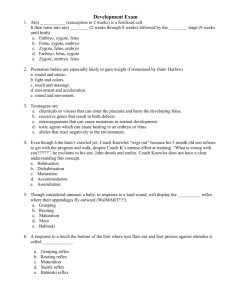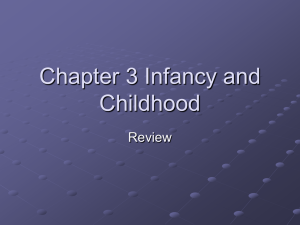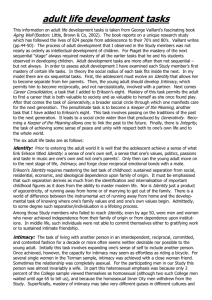Developmental Psychology Practice Questions
advertisement
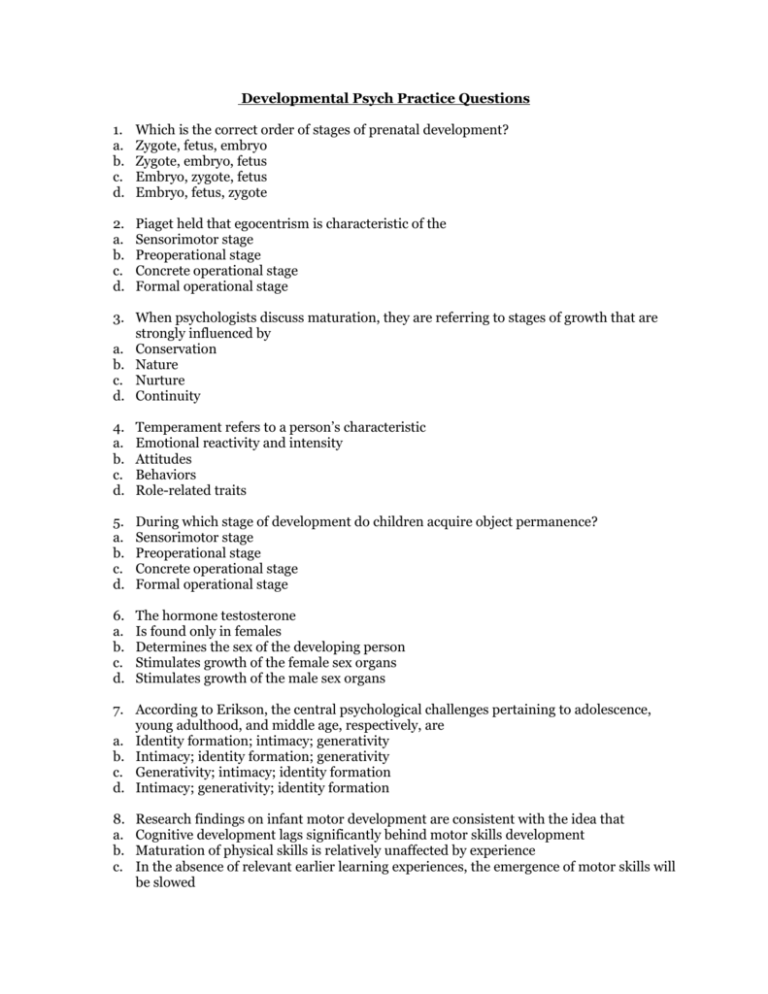
Developmental Psych Practice Questions 1. a. b. c. d. Which is the correct order of stages of prenatal development? Zygote, fetus, embryo Zygote, embryo, fetus Embryo, zygote, fetus Embryo, fetus, zygote 2. a. b. c. d. Piaget held that egocentrism is characteristic of the Sensorimotor stage Preoperational stage Concrete operational stage Formal operational stage 3. When psychologists discuss maturation, they are referring to stages of growth that are strongly influenced by a. Conservation b. Nature c. Nurture d. Continuity 4. a. b. c. d. Temperament refers to a person’s characteristic Emotional reactivity and intensity Attitudes Behaviors Role-related traits 5. a. b. c. d. During which stage of development do children acquire object permanence? Sensorimotor stage Preoperational stage Concrete operational stage Formal operational stage 6. a. b. c. d. The hormone testosterone Is found only in females Determines the sex of the developing person Stimulates growth of the female sex organs Stimulates growth of the male sex organs 7. According to Erikson, the central psychological challenges pertaining to adolescence, young adulthood, and middle age, respectively, are a. Identity formation; intimacy; generativity b. Intimacy; identity formation; generativity c. Generativity; intimacy; identity formation d. Intimacy; generativity; identity formation 8. a. b. c. Research findings on infant motor development are consistent with the idea that Cognitive development lags significantly behind motor skills development Maturation of physical skills is relatively unaffected by experience In the absence of relevant earlier learning experiences, the emergence of motor skills will be slowed d. In humans, the process of maturation may be significantly altered by cultural factors 9. Compared to when he was younger, 4-year-old Antonio is better able to empathize with his friend’s feelings and thoughts. This growing ability to take another’s perspective indicates that Antonio is acquiring a. Self-concept b. Schema c. Temperament d. Theory of mind 10. a. b. c. d. In preconvention morality, the person Obeys out of a sense of social duty Conforms to gain social approval Obeys to avoid punishment or gain concrete rewards Follows the dictates of his or her conscience 11. A person’s general ability to think abstractly is ____ intelligence; this ability generally ____ with age. a. Fluid; increases b. Fluid; decreases c. Crystallized; increases d. Crystallized; decreases 12. An older person who can look back on life with satisfaction and reminisce with a sense of completion has attained Erikson’s stage of a. Generativity b. Intimacy c. Isolation d. Integrity 13. According to Piaget, the ability to reason through abstract propositions is indicative of the stage of a. Preoperational thought b. Concrete operations c. Formal operations d. Fluid intelligence 14. a. b. c. d. Longitudinal research Compares people of different ages Studies the same people at different times in the lifespan Usually involves a larger sample than cross-sectional research Usually involves a smaller sample than cross-sectional research 15. Insecurely attached infants who are left by their mothers in an unfamiliar setting often will a. Be unable to be soothed or calmed b. Explore their new surroundings confidently c. Be indifferent toward their mothers upon return d. Display little emotion at any time 16. The term critical period refers to a. b. c. d. Prenatal development The initial 2 Horus after a child’s birth The preoperational stage A restricted time for learning 17. a. b. c. d. Of the following, parents are most likely to influence their children’s Temperament Personality Faith or religious belief Emotional reactivity 18. ___ proposed that humans have a language acquisition device which biologically predisposes us to learn complex language. a. Whorf b. Lambert c. Chomsky d. Skinner 19. Whose stage theory of moral development was based on how people reasoned about ethical dilemmas? a. Erik Erikson b. Jean Piaget c. Harry Harlow d. Lawrence Kohlberg 20. The social clock refers to a. An individual or society’s distribution of work and leisure time b. Adulthood responsibilities c. Typical ages for starting a career, marrying, and so on d. Age-related changes in one’s circle of friends 21. To which of Kohlberg’s levels would moral reasoning be based on the existence of fundamental human rights pertain? a. Pre-conventional morality b. Conventional morality c. Post-conventional morality d. Generative morality 22. Teratogens are a. Physical abnormalities in the developing fetus b. Cognitive abnormalities in the developing fetus c. Chemicals and viruses that cross the placenta d. Fertilized eggs 23. Underlying Alzheimer’s disease is deterioration in neurons that produce a. Epinephrine b. Norepinephrine c. Serotonin d. Acetylcholine 24. In one movie, a young girl finds that a flock of geese follows her wherever she goes because she was the first “object” they saw after they were born. This is an example of a. Conservation b. Imprinting c. Egocentrism d. Basic trust 25. As a child watches, a liquid is transferred from a tall, thin tube to a short, wide jar. The child is asked if there is now less liquid in order to determine if she has mastered a. The schema for liquids b. The concept of object permanence c. The concept of conservation d. The ability to reason abstractly 26. When a baby is started they may exhibit the _____. a. Moro reflex b. Grasping reflex c. Rooting reflex d. Babinski reflex 27. Harlow’s finding that baby monkeys prefer a terrycloth surrogate mother to a wire mother demonstrates the importance of a. imprinting on critical periods b. contact comfort c. acceptance d. good nutrition 28. A child and her father are walking. The child knows there are such things as birds but has never seen a bluebird before. Upon seeing one, she says “See the birdie,” and her father replies, “Yes, that’s a bluebird.” This example demonstrates a. assimilation b. accommodation c. conservation d. object permanence 29. The smallest distinctive sound unit of language, such as various vowel and consonant sounds, are known as a. semantics b. prototypes c. phonemes d. chunks 30. The Hopi Native American tribe has no past tense verbs and is argued to understand the concept of time differently. The argument that language influences the way people think was part of a. Whorf’s linguistic determinism theory b. Bandura’s social learning theory c. Lambert’s bilingual advantage theory d. Chomsky’s universal grammar theory
